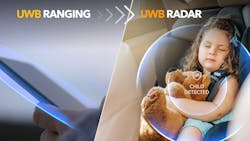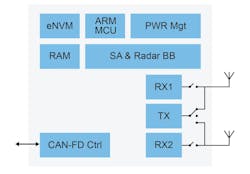Automotive UWB ICs Built for Ranging and Radar
This article is part of the TechXchange: Automotive Radar.
The Trimension NCJ29D6, a fully integrated, single-chip ultra-wideband (UWB) family launched by NXP Semiconductors, combines secure and precise real-time localization with short-range radar to address multiple automotive use cases with a single system. These include secure car access, child presence detection, intrusion alert, and gesture recognition, among others.
Devices from this family are expected to be on the road in model year 2025 vehicles.
Trimension NCJ29D6 is compliant to IEEE 802.15.4 HRP UWB PHY and IEEE 802.15.4z BPRF/HPRF UWB PHY. It’s designed for secure ranging applications and radar applications in an automotive environment.
Besides supporting Digital Key functionality for secure hands-free car access, the NCJ29D6 enhances this feature with radar capabilities. This enables applications such as child presence detection (CPD) and kick-sensing for easy trunk access. With combined ranging and radar support, the NCJ29D6 maximizes system value and reduces system cost.
UWB Chip Family Members
The new family includes the NCJ29D6B, a UWB device for secure car access, said to deliver enhanced ranging performance, reduced system costs, higher security, and turn-key software.
Another member of the family is the pin-to-pin compatible NCJ29D6A, the industry’s first automotive device combining both ranging and short-range UWB radar into a single chip with an integrated MCU, according to NXP. This enables OEMs to transform a single UWB-based car access system into a fully flexible, multipurpose platform, enabling multiple use cases with the same hardware and allowing OEMs to eliminate redundant systems and reduce cost, space, and weight.
For example, OEMs can leverage their secure car access system to also deliver features such as CPD, in compliance with the U.S. Hot Cars Act and European NCAP roadmap. This helps streamline development and enables OEMs and Tier-1s to add additional features through software updates, helping to reduce the total cost of ownership and accelerating time-to-market for new features.
“UWB will drive new advancements in the consumer automotive experience, and this is only the beginning of what it will enable,” said Markus Staeblein, Senior Vice President and General Manager Secure Car Access, NXP Semiconductors. “Automotive OEMs and Tier-1s will benefit from a single system that can deliver multiple new software-defined experiences enabled by Trimension NCJ29D6 UWB ICs over time. Building on our expertise and standardization efforts in bodies such as the Car Connectivity Consortium (CCC) and the FiRa Consortium, we are helping UWB become an essential part of the automotive ecosystem.”
Benefits of the NCJ29D6 Devices
The new NCJ29D6B enables enhanced secure car access, allowing users to access their car hands-free through a digital key on a UWB-enabled mobile phone. The NCJ29D6B also delivers a number of performance enhancements for maximum design flexibility. Higher RF sensitivity and two simultaneous operating receiver chains support antenna diversity and angle-of-arrival concepts to detect small changes in distance or direction of movement of other UWB-enabled devices.
With a focus on system cost, the NCJ29D6B features increased CPU performance, larger memory size, and high levels of integration, including an integrated digital CAN transceiver. As a result, developers can reduce the number of components per anchor to a single chip.
The pin-to-pin compatible NCJ29D6A extends the location features of the NCJ29D6B with short-range UWB radar. NXP said it’s the first automotive device to combine these features within a single chip with an integrated MCU. Taken together, this enables the NCJ29D6A to sense the environment around it. And, as mentioned, it allows OEMs to transform a single UWB-based system into a multipurpose platform.
In addition to secure car access, automotive OEMs can integrate in-cabin sensing for CPD and seat-belt reminder, a kick sensor for automatic trunk opening, as well as various kinds of smart gesture recognition.
Built-in Security
Designed with the expectation that the variety of physical and cybersecurity attacks on vehicles will increase over time, NXP’s new UWB family anticipates the need for integrated security capabilities. Both devices have features that exceed the ISO21434 Cyber Security Requirements.
In addition, the Car Connectivity Consortium (CCC) MAC and FiRa MAC announced the formation of the Joint Ultra-wideband (UWB) MAC PHY Working Group (JUMPWG) to develop and maintain the UWB technology specifications used in the CCC Digital Key. It will be led by Chair Jinjing Jiang from member company Apple.
The FiRa Consortium UWB MAC Technical Requirements prescribe UWB ranging protocols and behavior of the ranging devices. In addition, this specification defines elements such as how ranging protocol works, supported types of ranging, the parameters and format of the messages that are exchanged, and the encryption of ranging messages. It offers standard-compatible UWB ranging protocols docking directly to the customer application software, enabling and simplifying AUTOSAR architectures.
The new Trimension IC family expands NXP’s portfolio of Connected Car Consortium-based smart access solutions, including KW45/47 wireless MCUs for Bluetooth Low Energy, the NCx332x automotive NFC front end, the NCJ37x automotive secure element, and the FS24 family of automotive safety Mini CAN FD SBC.
Read more articles in the TechXchange: Automotive Radar.

